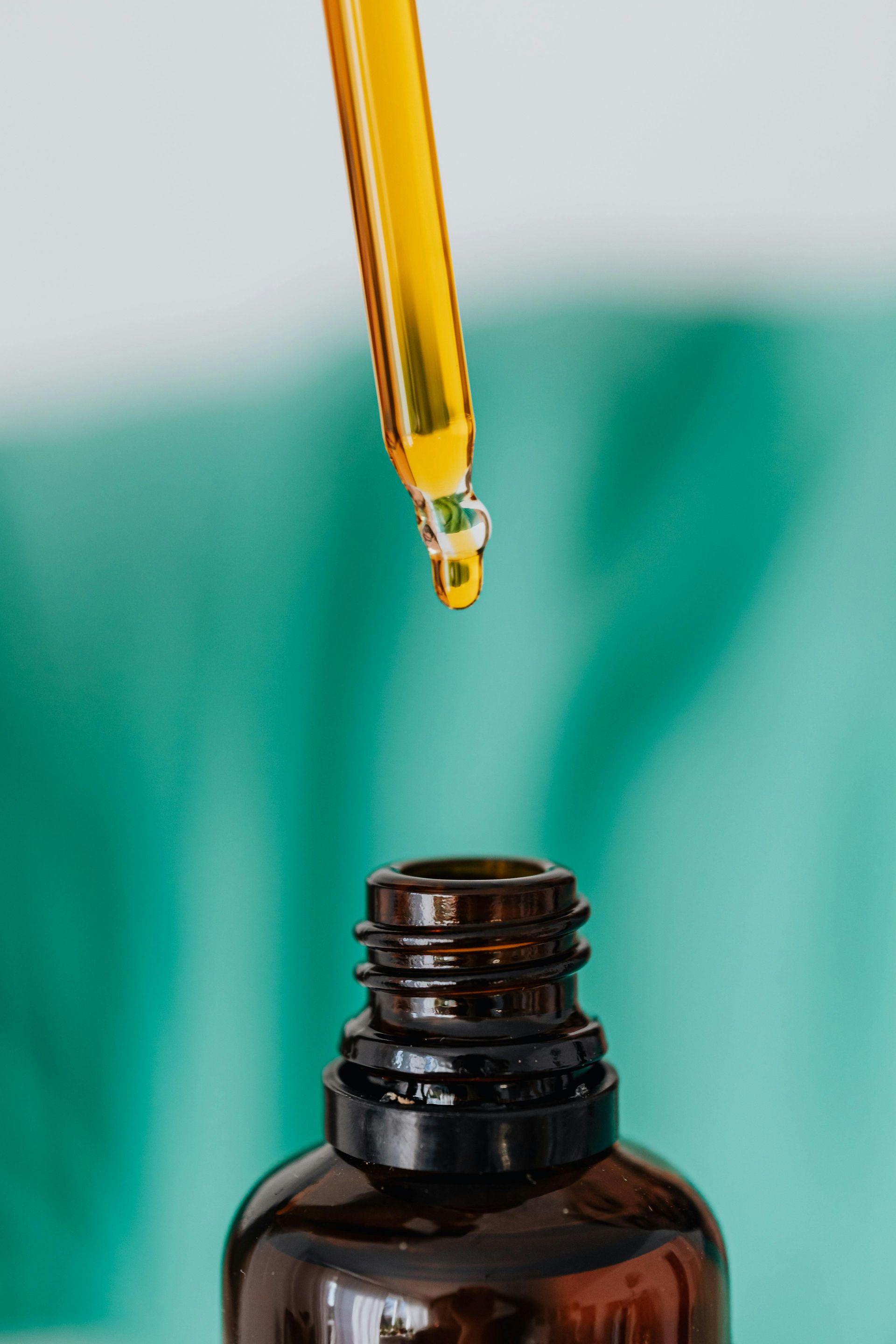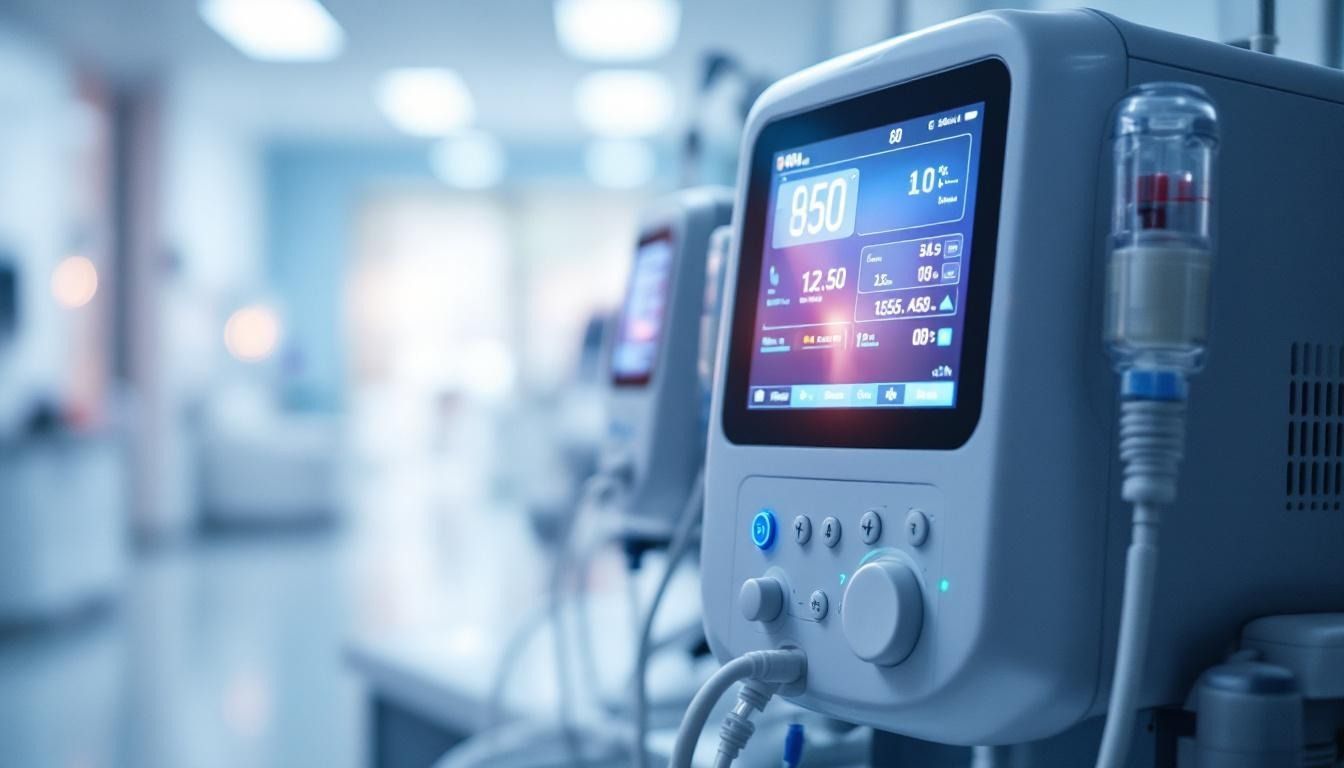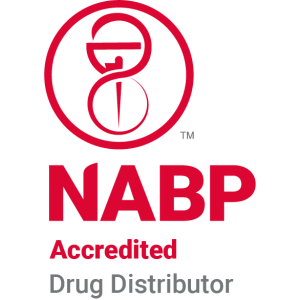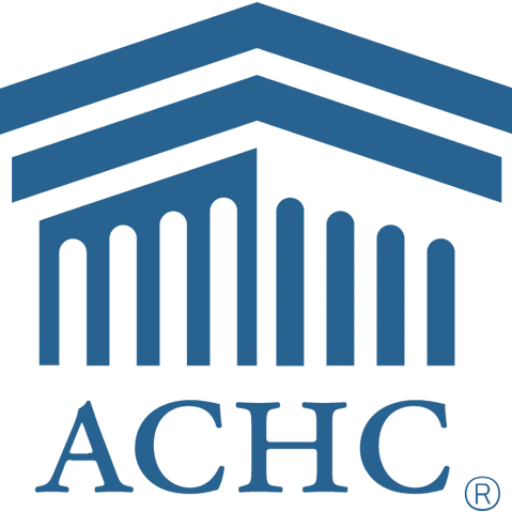Parenteral nutrition for malnourished
Introduction to Parenteral Nutrition
Parenteral nutrition (PN) is a critical intervention used to support patients who are unable to utilize their gastrointestinal tract for nutrition. This life-saving method administers nutrients directly into the bloodstream, bypassing the digestive system entirely. While its primary application has been in hospital settings for critically ill patients, its significance extends to various clinical conditions, emphasizing the necessity of careful monitoring and tailored approaches. This article delves into the comprehensive aspects of PN, including its indications, benefits, complications, and specific applications in oncology and surgical patients.
Basics of Parenteral Nutrition
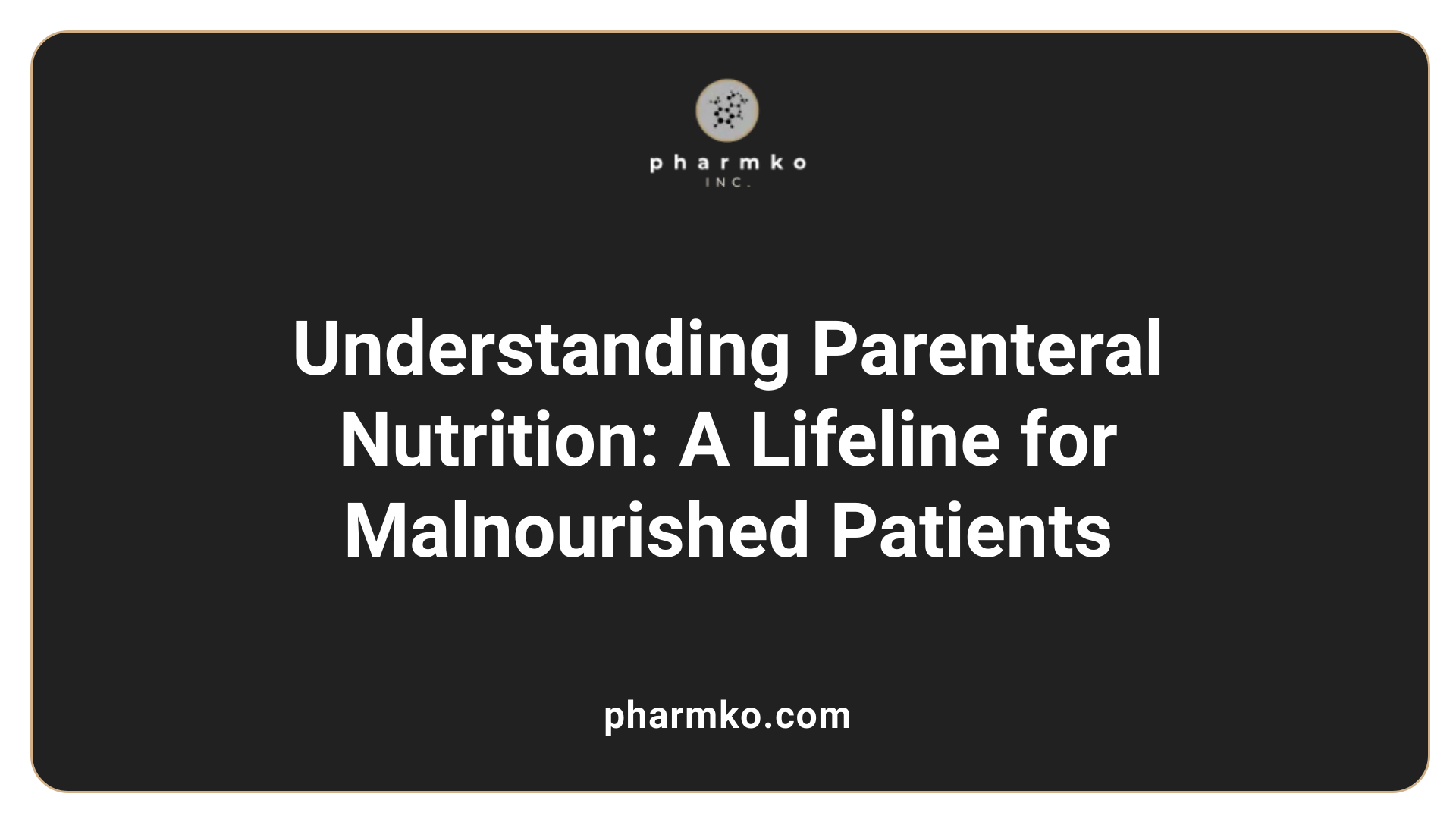
What is parenteral nutrition (PN) and when is it used for malnutrition treatment?
Parenteral nutrition (PN), commonly referred to as total parenteral nutrition (TPN), is a critical method for supplying essential nutrients directly into the bloodstream. It's specifically designed for patients who cannot properly digest or absorb nutrients due to various gastrointestinal dysfunctions. This makes it an essential treatment option for individuals suffering from conditions like short bowel syndrome, bowel obstructions, and enterocutaneous fistulas.
When addressing malnutrition, PN is particularly indicated for patients who show signs of severe malnutrition or are at risk for such conditions. Utilizing PN can help bridge the nutritional gap until patients can safely transition to oral or enteral nutrition, thereby preventing the complications that arise from inadequate nutrient intake.
Conditions warranting PN use
- Critical Illness : Hospitalized patients, especially those with severe gastrointestinal conditions or metabolic stress, are often candidates for PN.
- Inoperable GI Conditions : Patients with non-functioning or inaccessible intestines require PN to ensure they receive adequate nutrition.
- Post-operative Recovery : Surgical patients facing prolonged recovery may benefit significantly from PN, especially if they are unable to consume or absorb food.
Despite its vital role in managing malnutrition, PN does carry risks such as infections and metabolic imbalances, thus necessitating thorough monitoring to minimize potential complications. Given its importance, PN is considered a lifesaving intervention for those in need.
Indications and Safety Considerations of Total Parenteral Nutrition
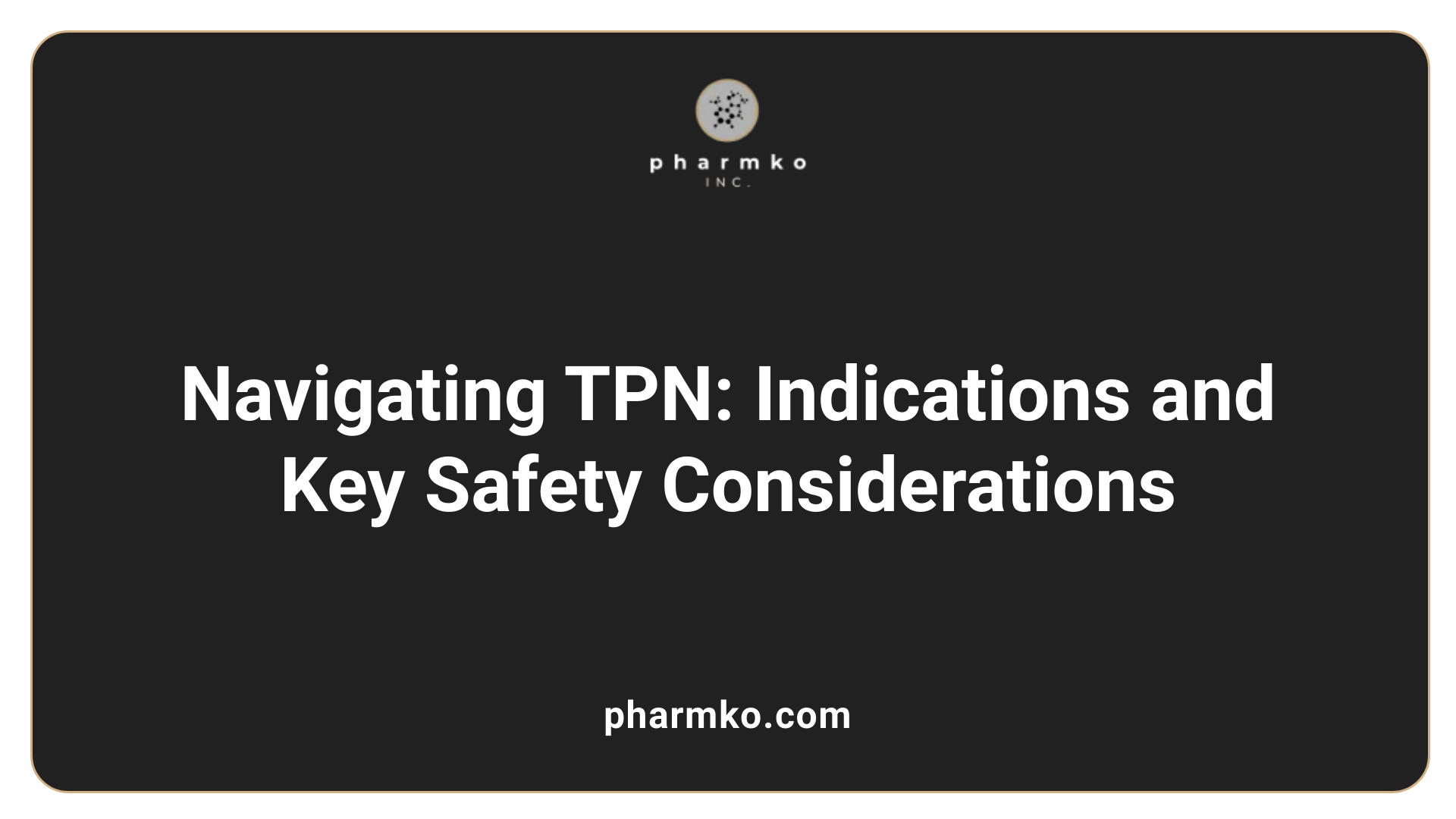
What are the indications and contraindications for starting Total Parenteral Nutrition (TPN) in patients?
Total Parenteral Nutrition (TPN) is indicated for patients experiencing severe malnutrition or conditions that impede adequate nutrition via the gastrointestinal tract. Key scenarios that warrant the use of TPN include:
- Intestinal failure : Conditions such as short bowel syndrome, severe intestinal obstruction, and ischemic bowel disease.
- High-output fistulas : When there is significant nutrient loss through abnormal openings.
- Severe catabolic states : Situations where the body’s nutrition needs exceed its intake ability due to stress or illness.
Additionally, TPN may be necessary for patients undergoing surgery and post-operative recovery when typical enteral nutrition isn't viable.
In contrast, there are certain contraindications to consider before initiating TPN:
- Active severe infections : Such as sepsis, since TPN can compromise immune responses.
- Specific anatomical considerations : Infants with less than 8 cm of remaining small bowel or patients with severe brain damage.
- Cardiovascular stability : Unstable conditions or severe liver diseases may also preclude the use of TPN.
While TPN can be lifesaving, careful patient selection is crucial. Regular monitoring is essential given the potential risks associated with TPN, including blood sugar fluctuations, catheter-related complications, liver dysfunction, and refeeding syndrome.
Comparing Total and Peripheral Parenteral Nutrition
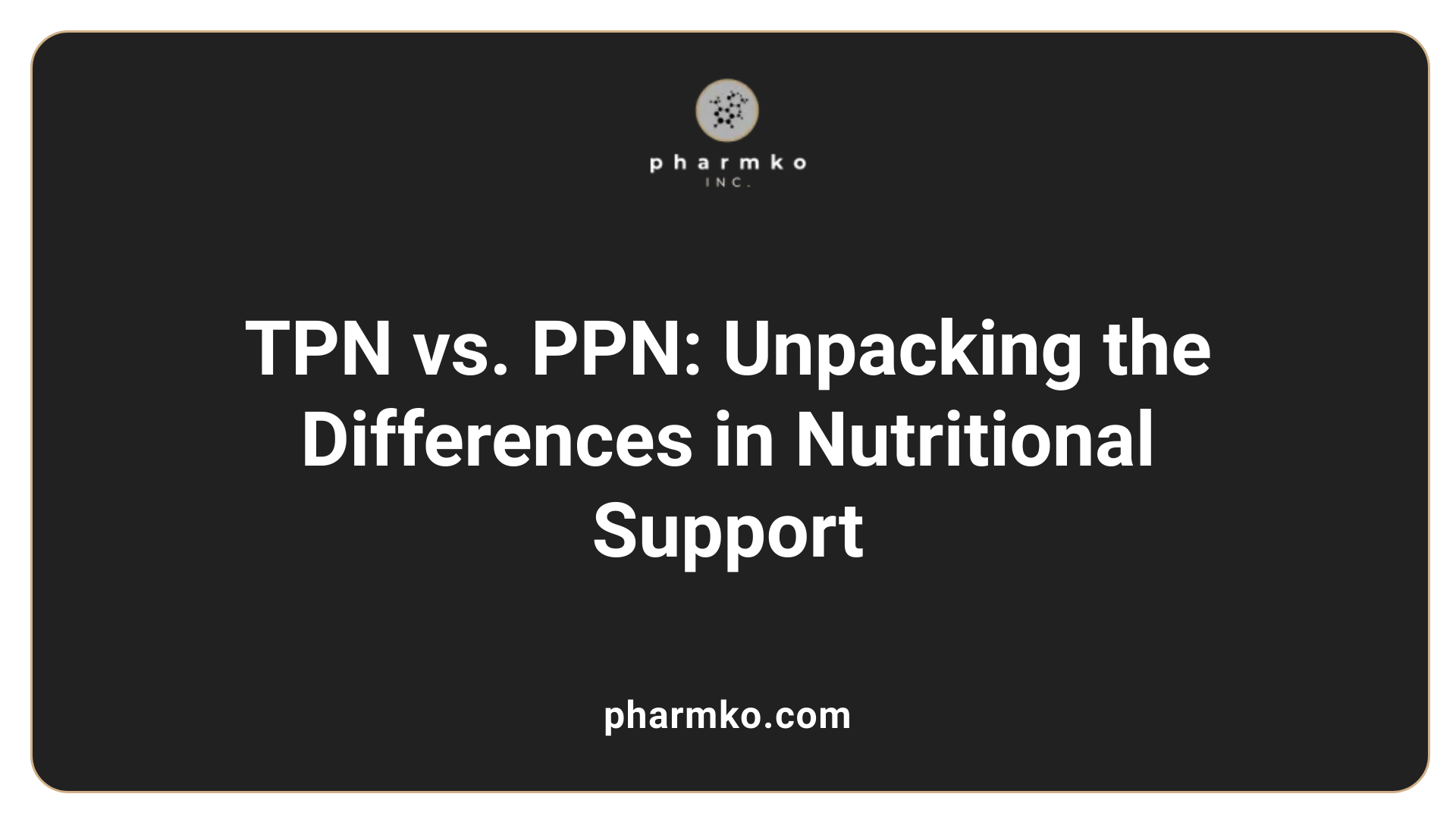
What are the key differences between TPN and PPN?
Total Parenteral Nutrition (TPN) offers a comprehensive nutritional solution administered via a central venous catheter. This method is suitable for patients unable to ingest food through traditional means, especially in severe circumstances like gastrointestinal diseases or oncology treatments. TPN solutions are typically hypertonic and contain a concentrated mix of carbohydrates, proteins, fats, vitamins, and minerals, allowing substantial caloric delivery to support recovery.
On the other hand, Peripheral Parenteral Nutrition (PPN) is intended for short-term use, delivered through peripheral IV lines. This approach is often employed for patients who can still consume some oral intake but need extra nutritional support. Since PPN solutions are less concentrated due to limitations in peripheral veins, the total caloric provision is lower than TPN, making it unsuitable for long-term reliance.
What are the benefits and complications of both?
Both TPN and PPN play vital roles in enhancing nutritional status, specifically for malnourished or critically ill patients.
| Aspect | Total Parenteral Nutrition (TPN) | Peripheral Parenteral Nutrition (PPN) |
|---|---|---|
| Administration | Central venous catheter for long-term use | Peripheral IV for short-term use |
| Caloric Concentration | High concentration allows for greater caloric intake | Lower concentration limits caloric delivery |
| Indications | Severe malnutrition, gut failure | Partial gut function, short-term nutritional needs |
| Complications | Metabolic issues, infection risks, refeeding syndrome | Fluid overload, phlebitis, electrolyte imbalances |
While clinical evidence reveals no significant differences in outcomes, the decision between TPN and PPN should be based on each patient's specific health needs, the severity of malnutrition, and the underlying conditions necessitating nutritional intervention.
Eligibility Criteria for Parenteral Nutrition
What condition qualifies a patient for parenteral nutrition?
Patients may qualify for parenteral nutrition (PN) if they are unable to meet their nutritional needs via oral or enteral methods due to conditions such as intestinal failure, short bowel syndrome, inflammatory bowel diseases, or severe gastrointestinal obstructions. PN is a life-saving intervention that delivers essential nutrients like carbohydrates, lipids, vitamins, and amino acids directly into the bloodstream, typically through a central line for safety due to its hypertonicity.
Guidelines for initiation
Key indications for initiating PN include:
- Malnourished status : Individuals demonstrating significant malnutrition or at risk due to conditions affecting nutrient absorption.
- Inability to tolerate enteral nutrition (EN) : When EN is inadequate or not tolerated, PN becomes essential.
- Timing : Initiation of PN should occur within 3-6 days for patients identified as at risk of malnutrition.
Monitoring and safety considerations
Careful monitoring for potential metabolic and infectious complications is necessary. This highlights the importance of proper assessment and adherence to guidelines for effective use of parenteral nutrition in supporting patients with severe digestive issues.
Role of Parenteral Nutrition in Oncology Patients
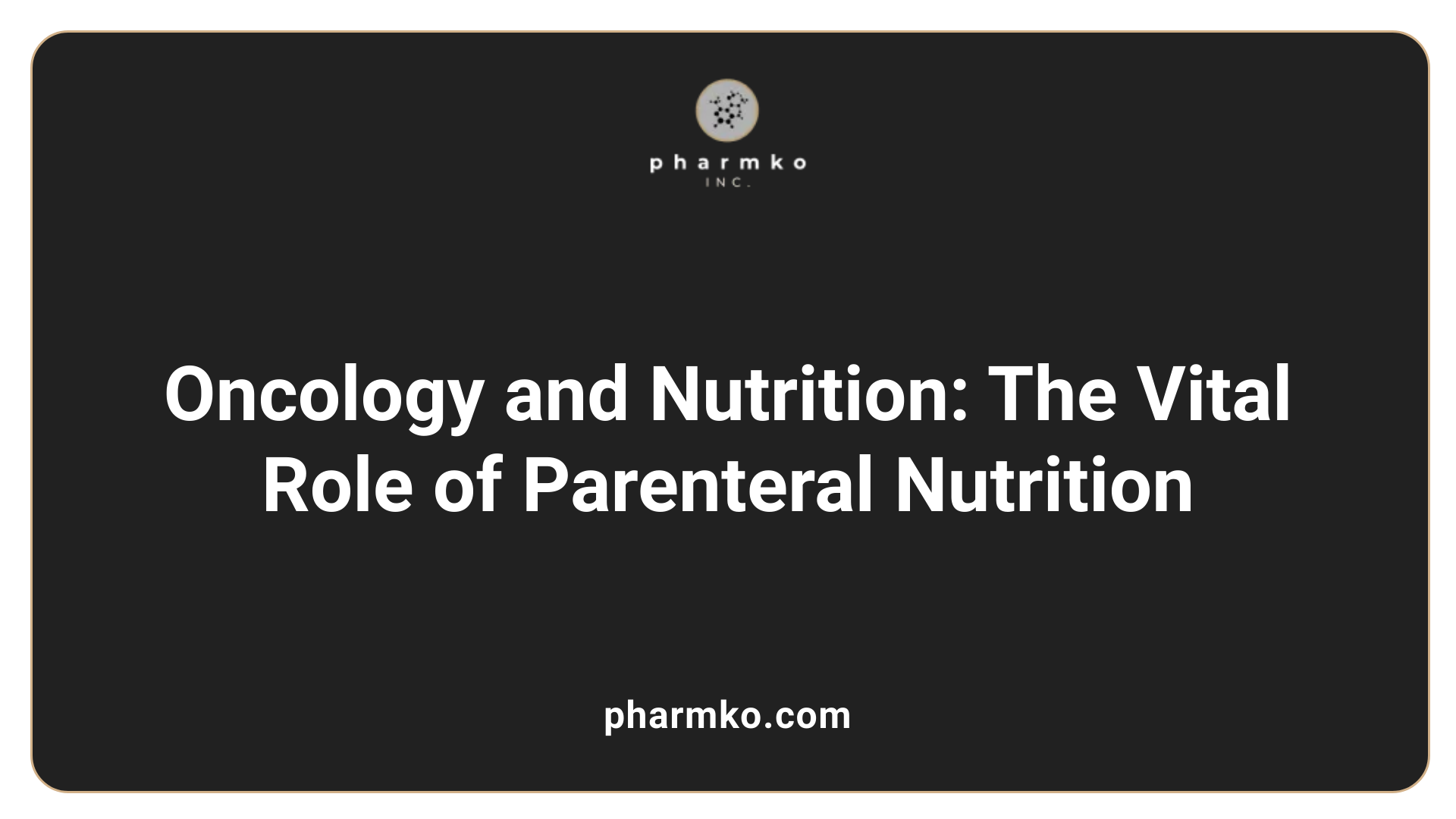
Nutritional Management in Oncology
Malnutrition is a significant challenge faced by oncology patients, with studies revealing that up to 83% of this population are affected. Treatment-related side effects, like nausea, vomiting, and anorexia, combined with gastrointestinal complications, can severely impact a patient's ability to maintain adequate nutrition.
Parenteral nutrition (PN) serves as a crucial intervention for those unable to fulfill their dietary needs through oral or enteral means. It is designed to deliver essential nutrients directly into the bloodstream, thereby bypassing the gastrointestinal tract. This method is particularly beneficial for patients experiencing severe malnutrition or those at risk due to their cancer diagnosis and treatment regimen.
Benefits of PN for Cancer Patients
The benefits of PN for malnourished oncology patients are multifold:
- Nutrient Delivery : PN provides tailored solutions containing macronutrients and micronutrients, essential for improving nutritional status.
- Support for Recovery : Early nutritional support can enhance patient compliance with treatment and reduce weight loss and muscle wasting.
- Improved Quality of Life : Maintaining strength and energy levels through adequate nutrient intake allows patients to better cope with the physical demands of their cancer treatment.
Aiming for at least 1 g/kg/day of protein, or up to 1.5 g/kg/day in more severe cases, these protein recommendations are vital in supporting immune function and recovery. Thus, early initiation of PN is proactive in managing malnutrition, ultimately impacting treatment outcomes and survival positively.
| Nutritional Aspects | Recommendations | Importance |
|---|---|---|
| Protein Intake | 1 g/kg/day to 1.5 g/kg/day | Supports recovery and immune function |
| Timing of PN Initiation | Within 3 to 7 days of deficiency | Reduces weight loss and improves compliance |
| Overall Nutritional Status | Essential for treatment efficacy | Enhances quality of life |
Guidelines for Administering Parenteral Nutrition
What are some guidelines and best practices for administering parenteral nutrition?
Implementing safe and effective parenteral nutrition (PN) requires a meticulous multidisciplinary approach. This includes the collaboration of a healthcare team consisting of doctors, nurses, dietitians, and pharmacists who are experienced in PN management.
Establishing Goals and Regular Monitoring
During the initial assessment, the healthcare team should establish clear goals for PN, which should be reviewed regularly, particularly during follow-ups. For patients in unstable condition, daily evaluations are necessary, complemented by daily weight measurements and biochemical assessments to monitor nutritional status and prevent complications.
Managing Nutritional Status
Attention must be given to electrolyte levels and liver function as part of the monitoring process. The nutritional composition of PN solutions should be personalized based on laboratory results to provide a balanced mix of macronutrients and micronutrients tailored to the patient's requirements.
Infection Prevention
Sterile techniques are paramount during the administration of TPN to minimize the risk of infections. Following strict protocols ensures the safe delivery of nutrients into the bloodstream. As patients progress, adjustments to the PN regimen may be needed, requiring careful reassessment of their nutritional needs throughout their treatment journey.
Identifying and Managing Complications of Total Parenteral Nutrition
What are the potential complications associated with Total Parenteral Nutrition?
Complications of Total Parenteral Nutrition (TPN) can pose significant challenges in patient care. They encompass various metabolic, infectious, and mechanical issues that require vigilant monitoring and management:
-
Metabolic Complications:
- Electrolyte Imbalances: Fluctuations in key electrolytes can lead to serious health issues.
- Hyperglycemia: Elevated blood sugar levels are common, necessitating insulin administration alongside TPN.
- Refeeding Syndrome: Patients may experience dangerous shifts in electrolytes and fluids, especially when transitioning from starvation to feeding.
- Hepatic Issues: Conditions like hepatic steatosis and cholestasis can affect long-term TPN patients, inhibiting liver function and overall health.
-
Infectious Complications:
- Sepsis and Catheter-Related Infections: Central venous lines used for TPN increase the risk of infections, leading to potentially life-threatening situations.
-
Mechanical Issues:
- Catheter placement problems or malfunctions can impede effective nutrient delivery.
What preventive measures can be taken to minimize these complications?
To ensure safe administration and minimize complications during TPN therapy, several strategies can be employed:
-
Regular Monitoring: Consistent assessment of blood glucose levels, electrolytes, and liver function tests is essential to detect and correct imbalances promptly.
-
Nutritional Assessments: Prior to and during TPN, thorough evaluations of patient nutritional needs should guide adjustments in nutrient formulations.
-
Infection Control Protocols: Vigilant adherence to aseptic techniques during catheter insertion and maintenance reduces infection risks.
-
Patient Education: Training patients or caregivers on the proper handling of TPN can help in preventing complications related to catheter care.
By implementing these measures, healthcare providers can better manage the risks associated with TPN and improve patient outcomes.
Effectiveness and Research on Parenteral Nutrition
What does research say about the effectiveness of parenteral nutrition?
Research indicates that parenteral nutrition (PN) is an effective intervention for addressing malnutrition in patients unable to receive oral or enteral nutrition, particularly in hospitalized individuals. A comprehensive meta-analysis of 27 trials highlighted that nutritional support through PN led to a significant reduction in mortality rates by 27% in the intervention group.
More specifically, malnourished patients experienced even greater advantages from PN, shown through increased caloric and protein intake, leading to notable improvements in their nutritional status. Notably, these patients achieved better outcomes compared to those who received standard care. Despite these benefits, PN does necessitate careful monitoring due to associated risks, including metabolic complications, which can arise during treatment.
Effectiveness across conditions
The implementation of PN is crucial for various patient populations, especially those with conditions that impair gastrointestinal function. Clinical guidelines advocate initiating PN within 3 to 6 days for patients at nutritional risk, underlining the therapy's significance in enhancing overall health outcomes for malnourished individuals. Additionally, studies reveal that in surgical contexts, pre-operative PN significantly enhances recovery and contributes to better surgical outcomes, highlighting its relevance in managing malnutrition effectively across clinical scenarios. Overall, the evidence supports the targeted use of PN as a lifesaving nutritional intervention.
Customizing Parenteral Nutrition for Patients
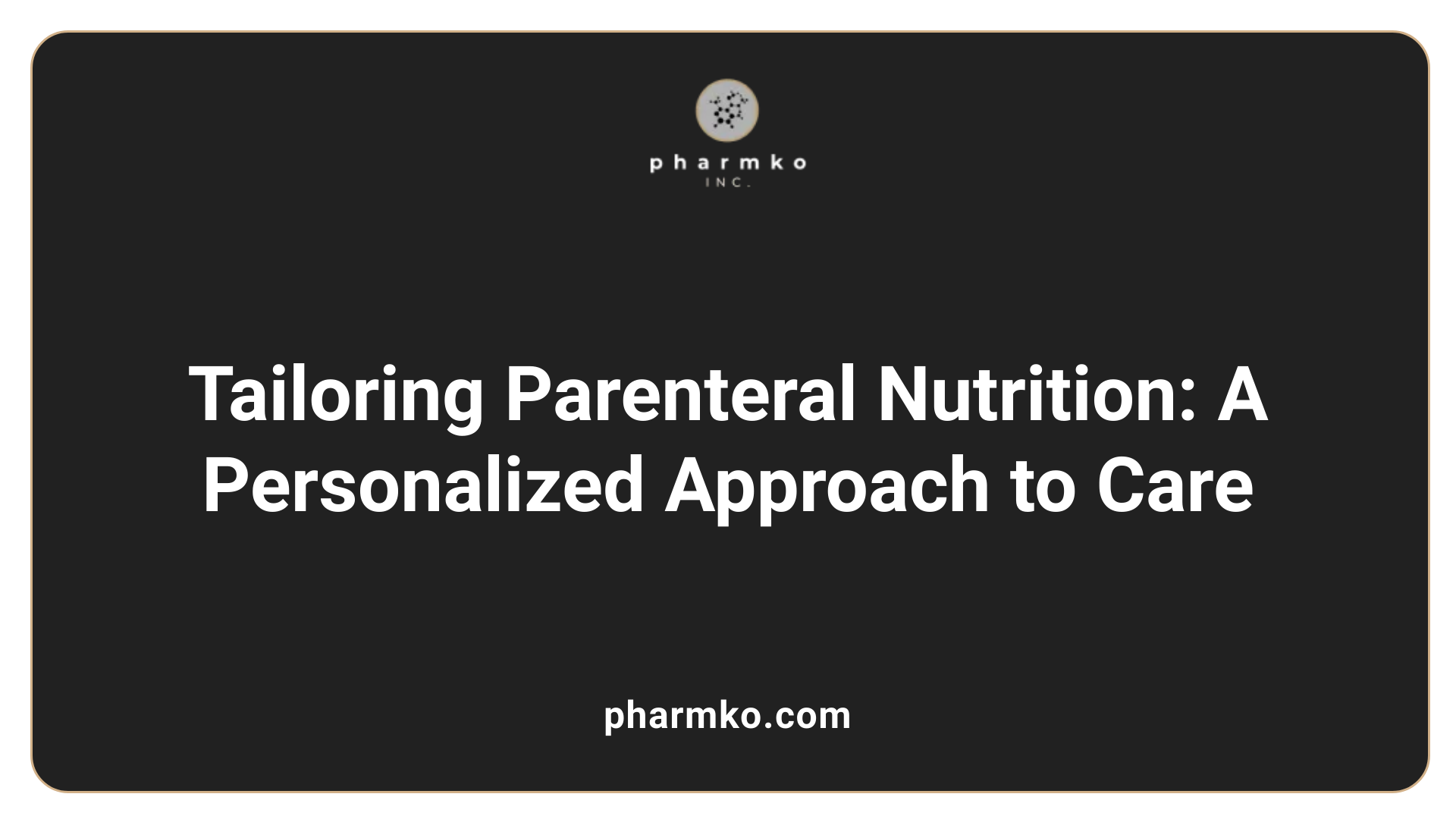
How should parenteral nutrition be tailored for malnourished individuals?
Parenteral nutrition (PN) for malnourished individuals begins with a comprehensive nutrition assessment. This helps identify specific nutrient needs and any underlying medical conditions that may impact their nutritional status. Tools like the Malnutrition Universal Screening Tool (MUST) or Nutrition Risk Screening (NRS-2002) are vital for evaluating nutrition risk effectively.
Personalizing PN formulations is critical. Macronutrient contributions should be individualized, especially protein intake, which is often higher, ranging from 1.2 to 2.5 g/kg/day depending on the patient's stress level and catabolic state. Additionally, careful monitoring of micronutrient levels is essential to prevent deficiencies during treatment.
Regular reassessments on the patient's health-related quality of life and functional outcomes ensure that any necessary adjustments in the nutrition care plan can be made promptly. Patient-centered approaches also play a crucial role in improving adherence to the PN regimen, ultimately optimizing clinical outcomes for those in need.
Nutrient assessments and their importance
Conducting accurate nutrient assessments is foundational in the customization of PN. This involves analyzing both macronutrient and micronutrient needs based on individual patient conditions. For instance, serum protein levels help gauge the severity of malnutrition and adjust protein intake in accordance with the patient's needs.
Moreover, gastrointestinal conditions or surgical history can change nutritional needs significantly, making regular evaluations indispensable. Continuous monitoring throughout the PN course allows healthcare providers to adapt and align the nutrition strategies with the patient's evolving health status.
Formulation Examples in Total and Peripheral Parenteral Nutrition
What are some examples of Total and Peripheral Parenteral Nutrition formulas?
Total parenteral nutrition (TPN) and peripheral parenteral nutrition (PPN) formulas are tailored to address the unique nutritional needs of patients who cannot consume food orally or absorb nutrients through the gastrointestinal tract.
Total Parenteral Nutrition (TPN) Formulas:
- High-Calorie Solutions: Typically recommended for patients with gastrointestinal disorders or severe malnutrition.
- Nutritional Composition:
- 25-30% of calories from fats
- 50-60% from carbohydrates
- High protein content of 1.5-2.5 g/kg/day
Peripheral Parenteral Nutrition (PPN) Formulas:
- Designed for short-term nutritional support, often used to supplement oral intake.
- Nutritional Composition:
- Fats contribute around 20-30% of total calories
- Lower protein levels compared to TPN
| Type | Nutritional Composition | Usage |
|---|---|---|
| TPN | High calories, 25-30% fats, 50-60% carbs | Severe malnutrition, GI issues |
| PPN | Lower concentrations, 20-30% fats | Short-term nutritional support |
Common commercial formulations include all-in-one (AIO) nutrient solutions and multi-chamber bags, which conveniently combine carbohydrates, proteins, fats, vitamins, and minerals. Adjustments to these formulas are based on individual patient needs and underlying medical conditions.
Conclusion
Parenteral nutrition remains a vital lifeline for those who cannot maintain adequate nutrition through traditional means. With its well-documented benefits in surgical and oncology patients and those with severe gastrointestinal ailments, PN offers significant therapeutic advantages when oral and enteral feeding avenues fail. The precision with which PN can be customized to meet individual patient needs underscores its essential role in modern medical practice. As evidence and research continue to evolve, the implementation of strict guidelines and best practices is paramount in maximizing the efficacy of PN, mitigating its risks, and ultimately improving patient outcomes across diverse medical settings.
References
- [PDF] Parenteral Nutrition Therapy for Malnutrition
- Parenteral Nutrition Overview - PMC - PubMed Central
- Malnutrition Treatment - Feeding Tube vs. IV Nutrition
- High-protein home parenteral nutrition in malnourished oncology ...
- Total parenteral nutrition: potion or poison? - ScienceDirect
- Outpatient Preoperative Parenteral Nutrition in Malnourished ...
- How TPN supports malnourished patients - Pharmko
- Exploring the malnutrition status and impact of total parenteral ...



